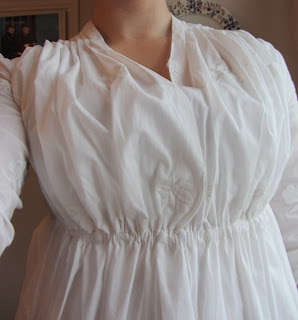I took a little turn to more common, everyday 18th century clothes with the black print swallow tail jacket and the red petticoat, so an apron was a natural accessory to them.
 |
| Trying on the clothes. The jacket still needs a stomacher and lacing. |
I made a black apron out of cotton batiste. Yes, I know, not very practical, but to me, the colour and the connotations of the apron itself were more important. I found some interesting facts when I was looking into apronwearing in history.
For example there are notes on estate records from the 17th century about middle and rural class women wearing aprons; of course an apron as a piece of clothing goes back to Iron Age and beyond. Usually the aprons of 17th and 18th century were made of bought, not homemade fabrics, and especially the Sunday apron (aka. the "better" apron) was an important purchase for rural women both in Finland and in Sweden. Usually these aprons were black or green, though in Central Finland and Southern Finland print patterned linen was the choice fabric for aprons. These characteristics are still represented in the different regional national costumes in Finland.
 |
| Finnish national costume of the Kokkola area, designed after late 18th century estate records |
As always there were also luxury laws that restricted the fashions, for example in the 17th century it was forbidden to decorate your apron with lace; caps and kerchiefs, yes, but not the aprons.
 |
| 18th century aprons, the upper class versions, Leloir's Histoire du Costume 1678-1725 |
The oldest types of Finnish aprons were narrow and fairly short cotton aprons that were copied from the fashions that the upper classes sported. Usually a woman would have had everyday aprons for work and then one or more finer aprons for special occasions.
 |
| Finnish national costume from Vehkalahti region. Also this vertically striped apron was a popular fashion. |
The connotations and beliefs connected to the apron were very versatile; as a rule, an apron was a symbol of a good woman and a mother, proof of her as a domestic, hard working, careful, modest, and patriotic person. According to Scandinavian folk beliefs, the most important aspect of the apron was not to protect the woman's clothes, but her reproductive organs. A pregnant woman could not go around in public without an apron because the pregnancy had to be protected from an evil eye. To meet a pregnant woman with no apron was very unlucky, she was thought to radiate bad energy with no protection.
Aprons were also used as talismans and for domestic spells. To keep the cows from running away the woman of the house would tie her kitchen apron at the cow byre door. In order to get a farm animal pregnant it helped to tie a pregnant woman's apron around the animal's neck.
Also, surprisingly, patching up an apron was allowed only to older women who were past their prime and who had entered spinsterhood. It was thought that to use or fix such broken talismans would cause other women to stray from what was good and proper. The same would happen if you lost or accidentally dropped your apron.
 |
| Finnish national costume from Masku region near Turku |
Sources:
Terttu Lehtimäki: http://www.nokiankylat.com/taivalkunta/kylalehti/lehti/tekstit/2002/lehti1/esiliina.html,
Sari Miettunen: http://www.ts.fi/teemat/sunnuntai/1073985621/Mekon+suoja+ja+siveyden+turva, interview with costume researcher Outi Sipilä.
http://www.kansallispuvut.fi/puvut/masku_np.htm
http://www.taitokeskipohjanmaa.fi/kokkolan_seudun_naisenpuku.htm
http://www.kansallispuvut.fi/puvut/vehkalahti_np.htm
http://thecostumersmanifesto.com/costumeoldsite/history/100pages/leloirX2.htm






























































